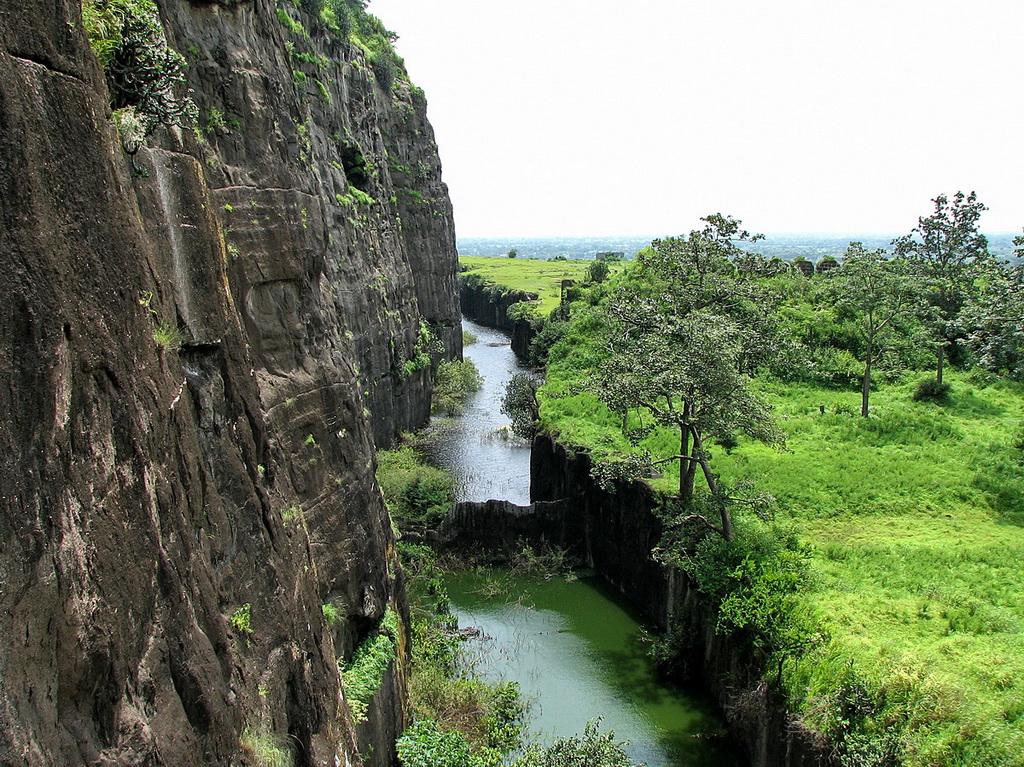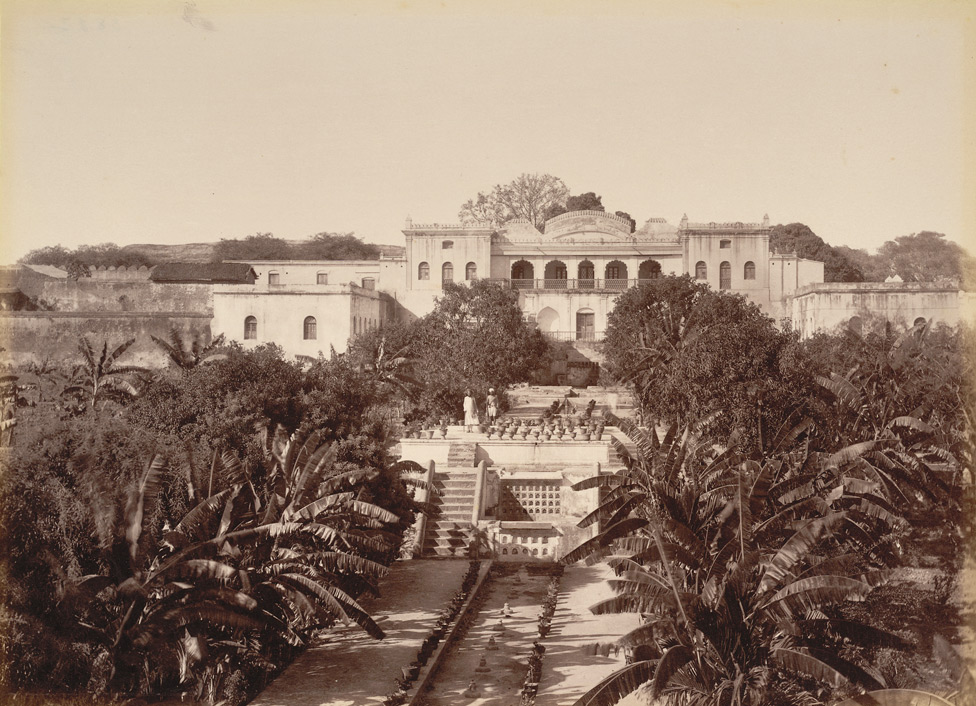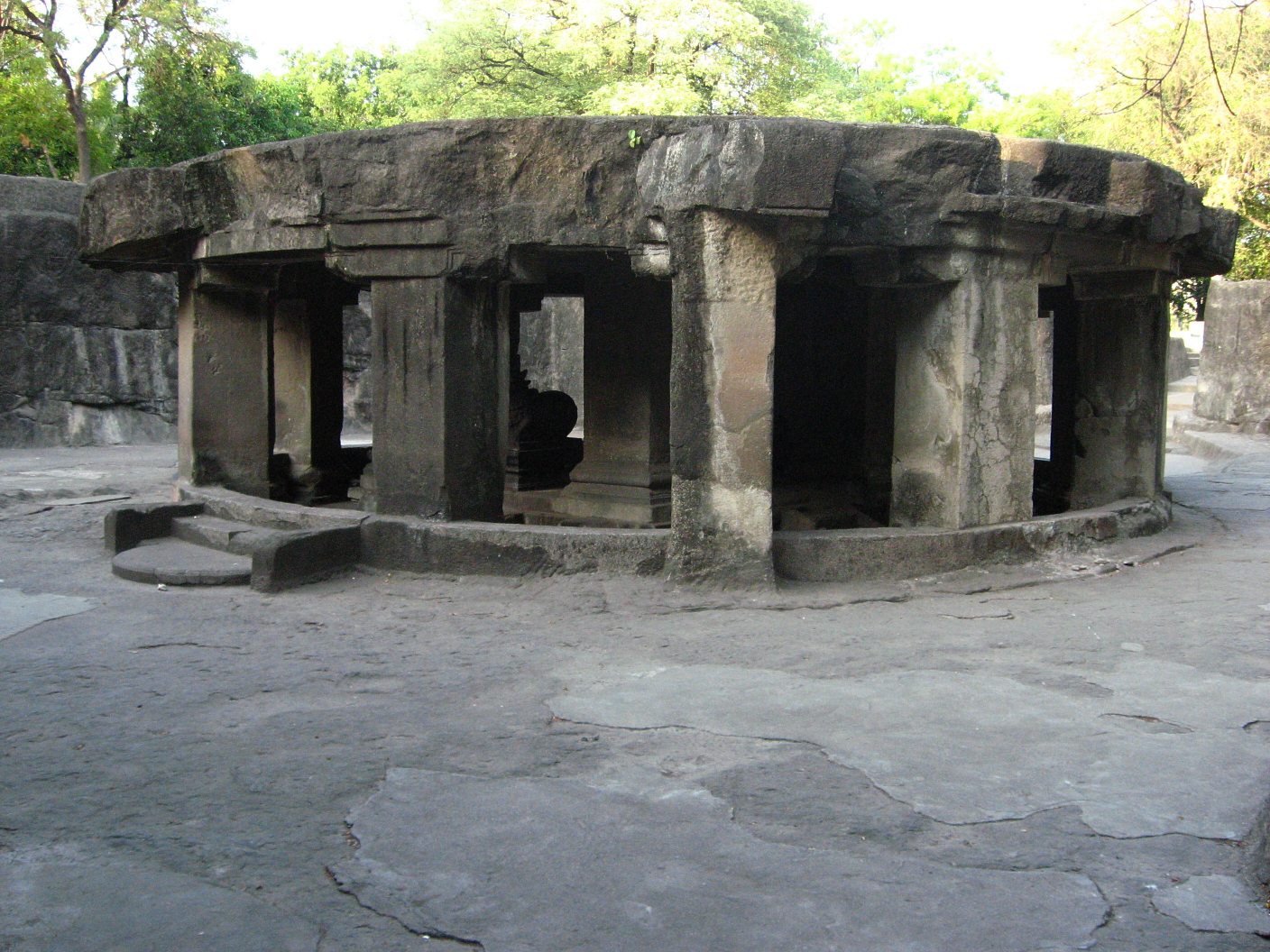|
Devagiri
Daulatabad Fort, also known as Devagiri Fort or Deogiri Fort, is a historic fortified citadel located in Daulatabad village near Aurangabad, Maharashtra, India. It was the capital of the Yadava dynasty (9th century–14th century CE), for a brief time the capital of the Delhi Sultanate (1327–1334), and later a secondary capital of the Ahmadnagar Sultanate (1499–1636). Around the 6th century CE, Devagiri emerged as an important uplands town near present-day Aurangabad, along caravan routes going towards western and southern India. The historical triangular fortress in the city was initially built around 1187 by the first Yadava king, Bhillama V. In 1308, the city was annexed by Sultan Alauddin Khalji of the Delhi Sultanate, which ruled over most of the Indian subcontinent. In 1327, Sultan Muhammad bin Tughluq of the Delhi Sultanate renamed the city from Devagiri to Daulatabad and shifted his imperial capital to the city from Delhi, ordering a mass migration of Delhi's ... [...More Info...] [...Related Items...] OR: [Wikipedia] [Google] [Baidu] |
Alauddin Khalji's Conquest Of Devagiri
Around 1308, the Delhi Sultanate ruler Alauddin Khalji sent a large army led by his general Malik Kafur to Devagiri, the capital of the Yadava king Ramachandra. Alauddin had earlier raided Devagiri in 1296, and forced Ramachandra to pay him tribute. However, Ramachandra had discontinued these tribute payments, and had given asylum to the Vaghela king Karna, whom Alauddin had displaced from Gujarat in 1304. A section of the Delhi army, commanded by Alp Khan, invaded Karna's principality in the Yadava kingdom, and captured the Vaghela princess Devaladevi, who later married Alauddin's son Khizr Khan. Another section, commanded by Malik Kafur captured Devagiri after a weak resistance by the defenders. Ramachandra agreed to become a vassal of Alauddin, and later, aided Malik Kafur in the Sultanate's invasions of the southern kingdoms. Date There is some confusion over the date of Alauddin's second invasion of Devagiri. His courtier Amir Khusrau dates this invasion to March ... [...More Info...] [...Related Items...] OR: [Wikipedia] [Google] [Baidu] |
Yadava Dynasty
The Seuna, Sevuna, or Yadavas of Devagiri (IAST: Seuṇa, –1317) was a Medieval Indian dynasty, which at its peak ruled a kingdom stretching from the Narmada river in the north to the Tungabhadra river in the south, in the western part of the Deccan region. Its territory included present-day Maharashtra, North Karnataka and parts of Madhya Pradesh, from its capital at Devagiri (present-day Daulatabad in modern Aurangabad district, Maharashtra). The Yadavas initially ruled as feudatories of the Western Chalukyas. Around the middle of the 12th century, as the Chalukya power waned, the Yadava king Bhillama V declared independence. The Yadava kingdom reached its peak under Simhana II, and flourished until the early 14th century, when it was annexed by the Khalji dynasty of the Delhi Sultanate in 1308 CE. Etymology The Seuna dynasty claimed descent from the Yadavas and therefore, its kings are often referred to as the "Yadavas of Devagiri". The correct name of the dynasty, ... [...More Info...] [...Related Items...] OR: [Wikipedia] [Google] [Baidu] |
Seuna (Yadava) Dynasty
The Seuna, Sevuna, or Yadavas of Devagiri ( IAST: Seuṇa, –1317) was a Medieval Indian dynasty, which at its peak ruled a kingdom stretching from the Narmada river in the north to the Tungabhadra river in the south, in the western part of the Deccan region. Its territory included present-day Maharashtra, North Karnataka and parts of Madhya Pradesh, from its capital at Devagiri (present-day Daulatabad in modern Aurangabad district, Maharashtra). The Yadavas initially ruled as feudatories of the Western Chalukyas. Around the middle of the 12th century, as the Chalukya power waned, the Yadava king Bhillama V declared independence. The Yadava kingdom reached its peak under Simhana II, and flourished until the early 14th century, when it was annexed by the Khalji dynasty of the Delhi Sultanate in 1308 CE. Etymology The Seuna dynasty claimed descent from the Yadavas and therefore, its kings are often referred to as the "Yadavas of Devagiri". The correct name of the ... [...More Info...] [...Related Items...] OR: [Wikipedia] [Google] [Baidu] |
Daulatabad Fort
Daulatabad Fort, also known as Devagiri Fort or Deogiri Fort, is a historic fortified citadel located in Daulatabad village near Aurangabad, Maharashtra, India. It was the capital of the Yadava dynasty (9th century–14th century CE), for a brief time the capital of the Delhi Sultanate (1327–1334), and later a secondary capital of the Ahmadnagar Sultanate (1499–1636). Around the 6th century CE, Devagiri emerged as an important uplands town near present-day Aurangabad, along caravan routes going towards western and southern India. The historical triangular fortress in the city was initially built around 1187 by the first Yadava king, Bhillama V. In 1308, the city was annexed by Sultan Alauddin Khalji of the Delhi Sultanate, which ruled over most of the Indian subcontinent. In 1327, Sultan Muhammad bin Tughluq of the Delhi Sultanate renamed the city from Devagiri to Daulatabad and shifted his imperial capital to the city from Delhi, ordering a mass migration of Delhi's ... [...More Info...] [...Related Items...] OR: [Wikipedia] [Google] [Baidu] |
Alauddin Khalji
Alaud-Dīn Khaljī, also called Alauddin Khilji or Alauddin Ghilji (), born Ali Gurshasp, was an emperor of the Khalji dynasty that ruled the Delhi Sultanate in the Indian subcontinent. Alauddin instituted a number of significant administrative changes, related to revenues, price controls, and society. He also successfully fended off several Mongol invasions of India. Alauddin was a nephew and a son-in-law of his predecessor Jalaluddin. When Jalaluddin became the Sultan of Delhi after deposing the Mamluks, Alauddin was given the position of ''Amir-i-Tuzuk'' (equivalent to master of ceremonies). After suppressing a revolt against Jalaluddin, Alauddin obtained the governorship of Kara in 1291, and the governorship of Awadh in 1296, after a profitable raid on Bhilsa. In 1296, Alauddin raided Devagiri, and acquired loot to stage a successful revolt against Jalaluddin. After killing Jalaluddin, he consolidated his power in Delhi, and subjugated Jalaluddin's sons in Multan. Over t ... [...More Info...] [...Related Items...] OR: [Wikipedia] [Google] [Baidu] |
Delhi Sultanate
The Delhi Sultanate was an Islamic empire based in Delhi that stretched over large parts of the Indian subcontinent for 320 years (1206–1526).Delhi Sultanate Encyclopædia Britannica Following the invasion of South Asia by the Ghurid dynasty, five dynasties ruled over the Delhi Sultanate sequentially: the Mamluk dynasty (1206–1290), the (1290–1320), the [...More Info...] [...Related Items...] OR: [Wikipedia] [Google] [Baidu] |
Bhillama V
Bhillama V (r. c. 1175-1191 CE) was the first sovereign ruler of the Seuna (Yadava) dynasty of Deccan region in India. A grandson of the Yadava king Mullagi, he carved out a principality in present-day Maharashtra by capturing forts in and around the Konkan region. Around 1175 CE, he grabbed the Yadava throne, supplanting the descendants of his uncle and an usurper. Over the next decade, he ruled as a nominal vassal of the Chalukyas of Kalyani, raiding the Gujarat Chaulukya and Paramara territories. After the fall of the Chalukya power, he declared sovereignty around 1187 CE, and fought with the Hoysala king Ballala II for control of the former Chalukya territory in present-day Karnataka. Around 1189 CE, he defeated Ballala in a battle at Soratur, but two years later, Ballala defeated him decisively. Rise to power According to Bhillama's Gadag inscription, he was a son of Karna, and a grandson of the Yadava ruler Mallugi. The 13th century Yadava court poet Hemadri gives a di ... [...More Info...] [...Related Items...] OR: [Wikipedia] [Google] [Baidu] |
Aurangabad, Maharashtra
Aurangabad ( is a city in the Indian state of Maharashtra. It is the administrative headquarters of Aurangabad district and is the largest city in the Marathwada region. Located on a hilly upland terrain in the Deccan Traps, Aurangabad is the fifth-most populous urban area in Maharashtra with a population of 1,175,116. The city is known as a major production center of cotton textile and artistic silk fabrics. Several prominent educational institutions, including Dr. Babasaheb Ambedkar Marathwada University, are located in the city. The city is also a popular tourism hub, with tourist destinations like the Ajanta and Ellora caves lying on its outskirts, both of which have been designated as UNESCO World Heritage Sites since 1983. Other tourist attractions include the Aurangabad Caves, Daulatabad Fort, Devagiri Fort, Grishneshwar Temple, Jama Mosque, Aurangabad, Jama Mosque, Bibi Ka Maqbara, Himayat Bagh, Panchakki and Salim Ali Lake. Historically, there were 52 Gates in Auran ... [...More Info...] [...Related Items...] OR: [Wikipedia] [Google] [Baidu] |
Muhammad Bin Tughluq
Muhammad bin Tughluq (1290 – 20 March 1351) was the eighteenth Sultan of Delhi. He reigned from February 1325 until his death in 1351. The sultan was the eldest son of Ghiyath al-Din Tughluq, founder of the Tughlaq dynasty. In 1321, the young Muhammad was sent by his father to the Deccan Plateau to fight a military campaign against the Kakatiya dynasty. In 1323, the future sultan successfully laid siege upon the Kakatiya capital in Warangal. This victory over King Prataparudra ended the Kakatiya dynasty. Muhammad ascended to the Delhi throne upon his father's death in 1325. Accounts by visitors of the Sultan Muhammad n describe him as an "inhuman eccentric" with bizarre character. The sultan is said to have ordered the massacre of all the inhabitants of the Hindu city of Kannauj. He is also known for his wild policy swings. Muhammad bin Tughluq had an interest in medicine. He was also skilled in several languages: Persian, Hindavi, Arabic, Sanskrit and Turkish. Ibn Ba ... [...More Info...] [...Related Items...] OR: [Wikipedia] [Google] [Baidu] |
Malik Ambar
Malik Ambar (1548 – 13 May 1626) was a Siddi military leader and prime minister who became a kingmaker and de facto ruler of the Ahmadnagar Sultanate in the Deccan region of India. Born in the Adal Sultunate, in present-day Ethiopia, Malik was sold by a slave merchant and brought to India as a slave. While in India he created a mercenary force numbering greater than 50,000 men. It was based in the Deccan region and was hired by local kings. Malik became a popular Prime Minister of the Ahmadnagar Sultanate, showing administrative acumen. He is also regarded as a pioneer in guerrilla warfare in the region. He is credited with carrying out a revenue settlement of much of the Deccan, which formed the basis for subsequent settlements. He is a figure of veneration to the Siddis of Gujarat. He humbled the might of the Mughals and Adil Shahs of Bijapur and raised the low status of the Nizam Shah.Michell, George & Mark Zebrowski. ''Architecture and Art of the Deccan Sultanates'' ... [...More Info...] [...Related Items...] OR: [Wikipedia] [Google] [Baidu] |
Pune
Pune (; ; also known as Poona, ( the official name from 1818 until 1978) is one of the most important industrial and educational hubs of India, with an estimated population of 7.4 million As of 2021, Pune Metropolitan Region is the largest in Maharashtra by area, with a geographical area of 7,256 sq km. It has been ranked "the most liveable city in India" several times. Pune is also considered to be the cultural and educational capital of Maharashtra. Along with the municipal corporation area of PCMC, PMC and the three cantonment towns of Camp, Khadki, and Dehu Road, Pune forms the urban core of the eponymous Pune Metropolitan Region (PMR). Situated {{convert, 560, m, 0, abbr=off above sea level on the Deccan plateau, on the right bank of the Mutha river,{{cite web , last=Nalawade , first=S.B. , url=http://www.ranwa.org/punealive/pageog.htm , title=Geography of Pune Urban Area , publisher=Ranwa , access-date=4 April 2008 , archive-url=https://web.archive.org/web/20071 ... [...More Info...] [...Related Items...] OR: [Wikipedia] [Google] [Baidu] |
Khalji Dynasty
The Khalji or Khilji ( Pashto: ; Persian: ) dynasty was a Turco- Afghan dynasty which ruled the Delhi sultanate, covering large parts of the Indian subcontinent for nearly three decades between 1290 and 1320.Dynastic Chart The Imperial Gazetteer of India, v. 2, ''p. 368.'' Founded by as the second dynasty to rule the Delhi Sultanate of India, it came to power through a rev ... [...More Info...] [...Related Items...] OR: [Wikipedia] [Google] [Baidu] |


.jpg)


.jpg)


